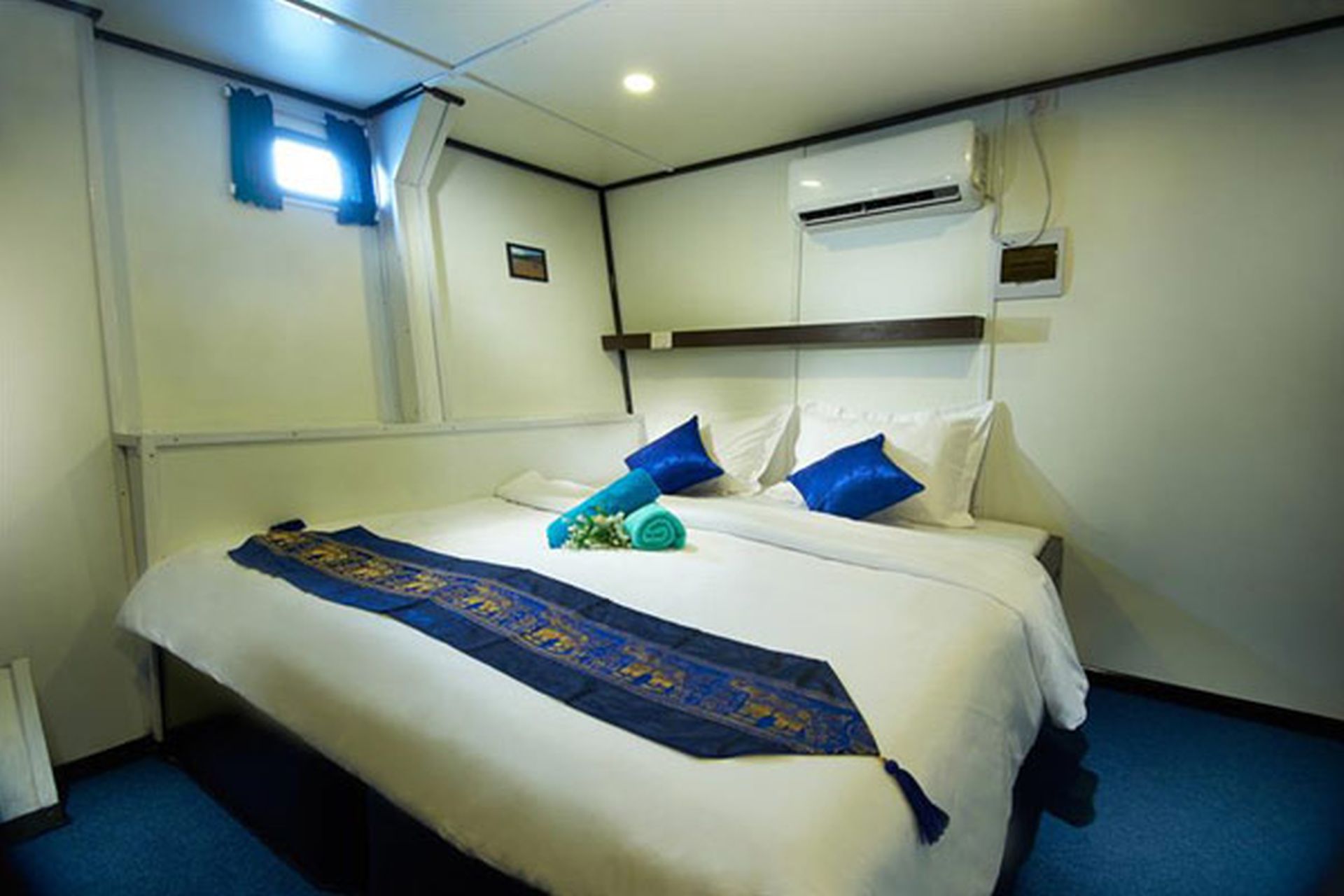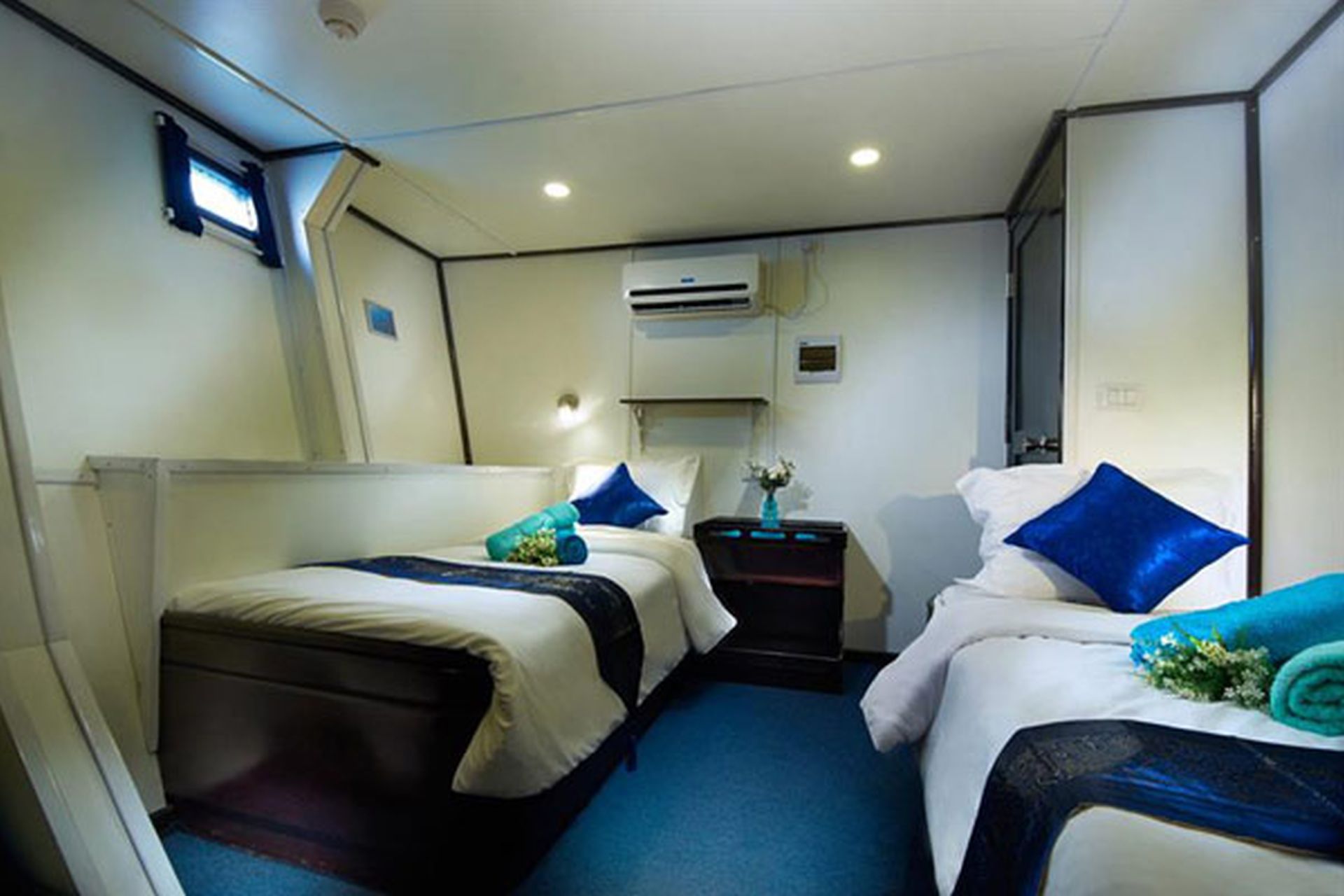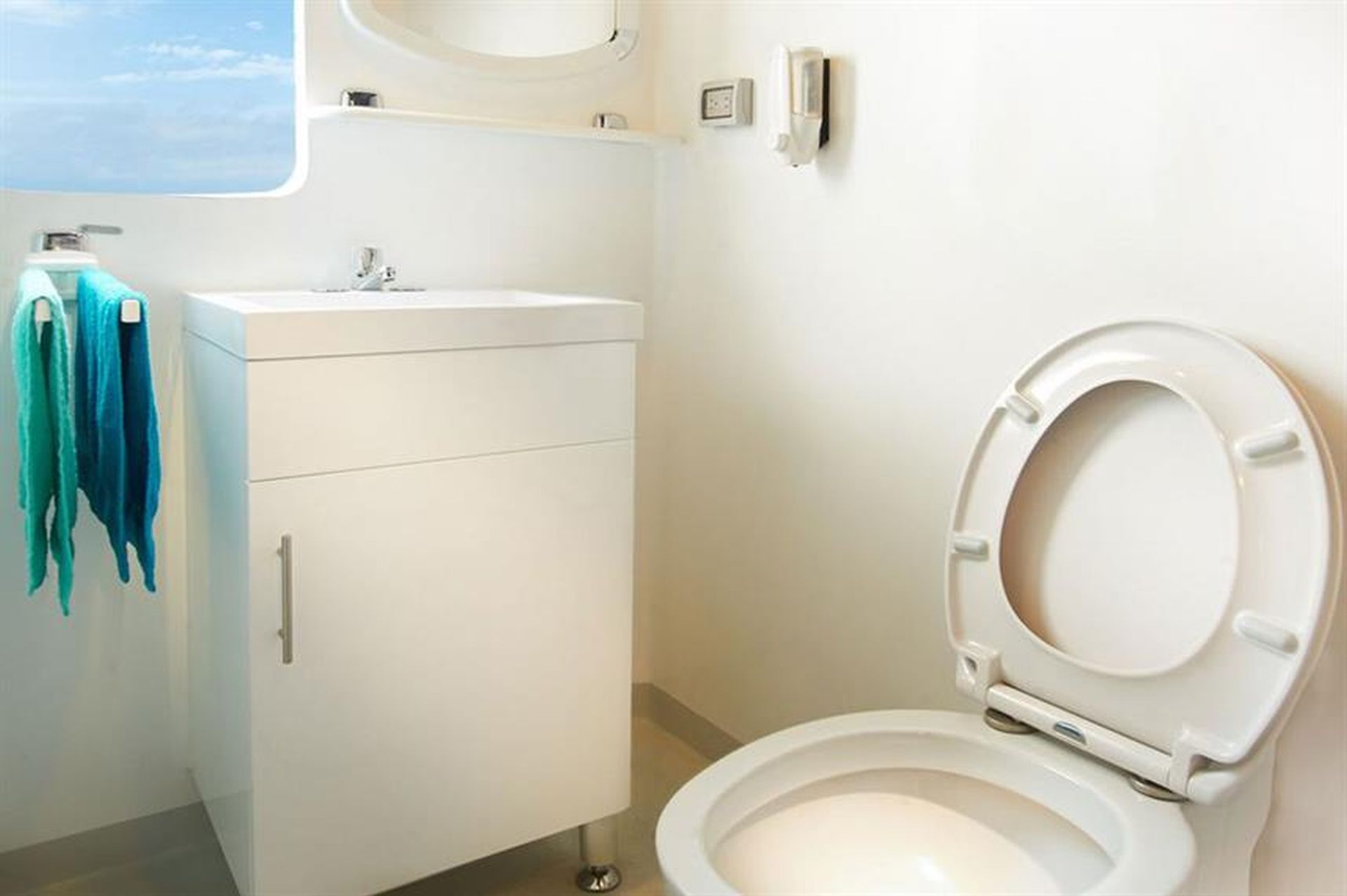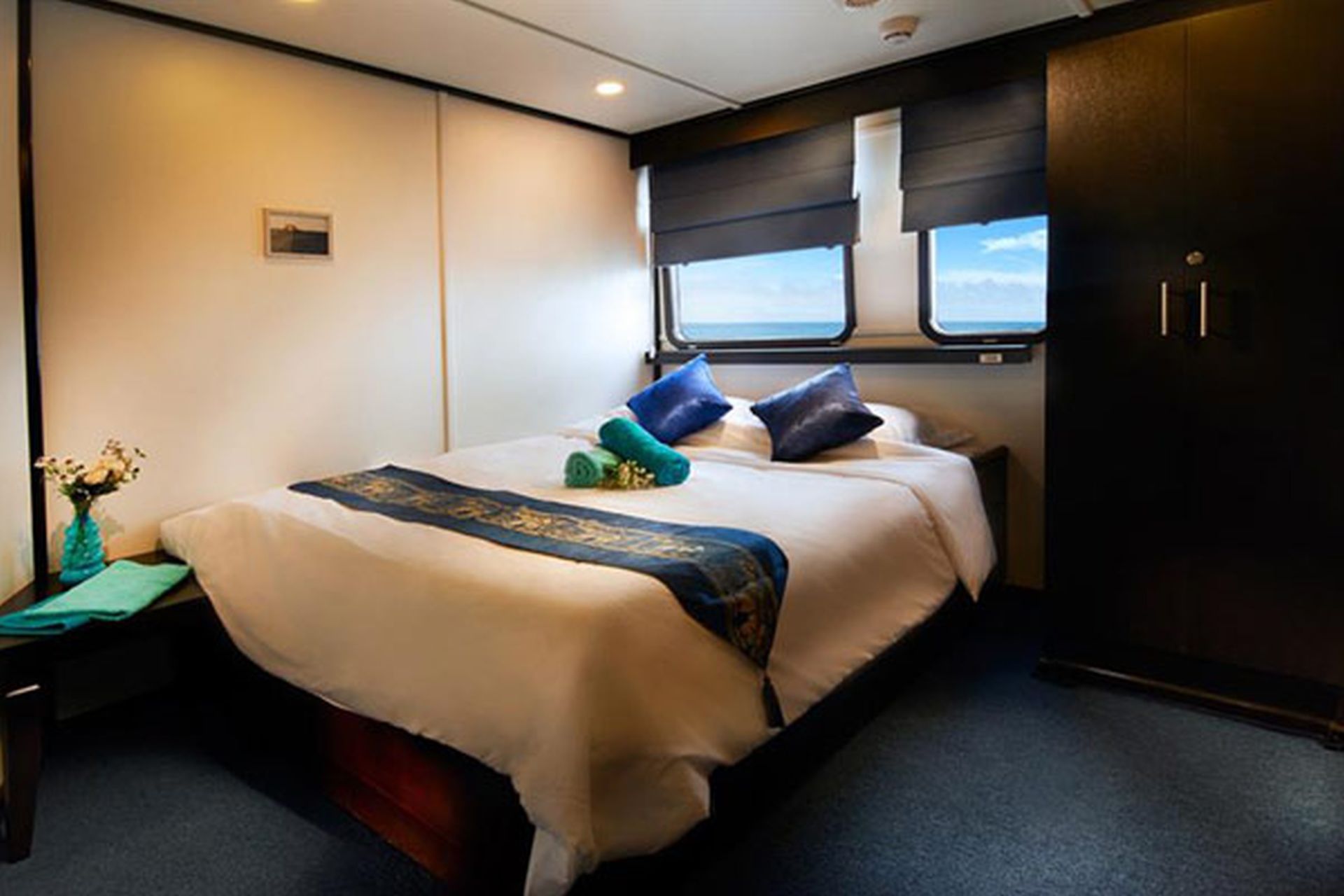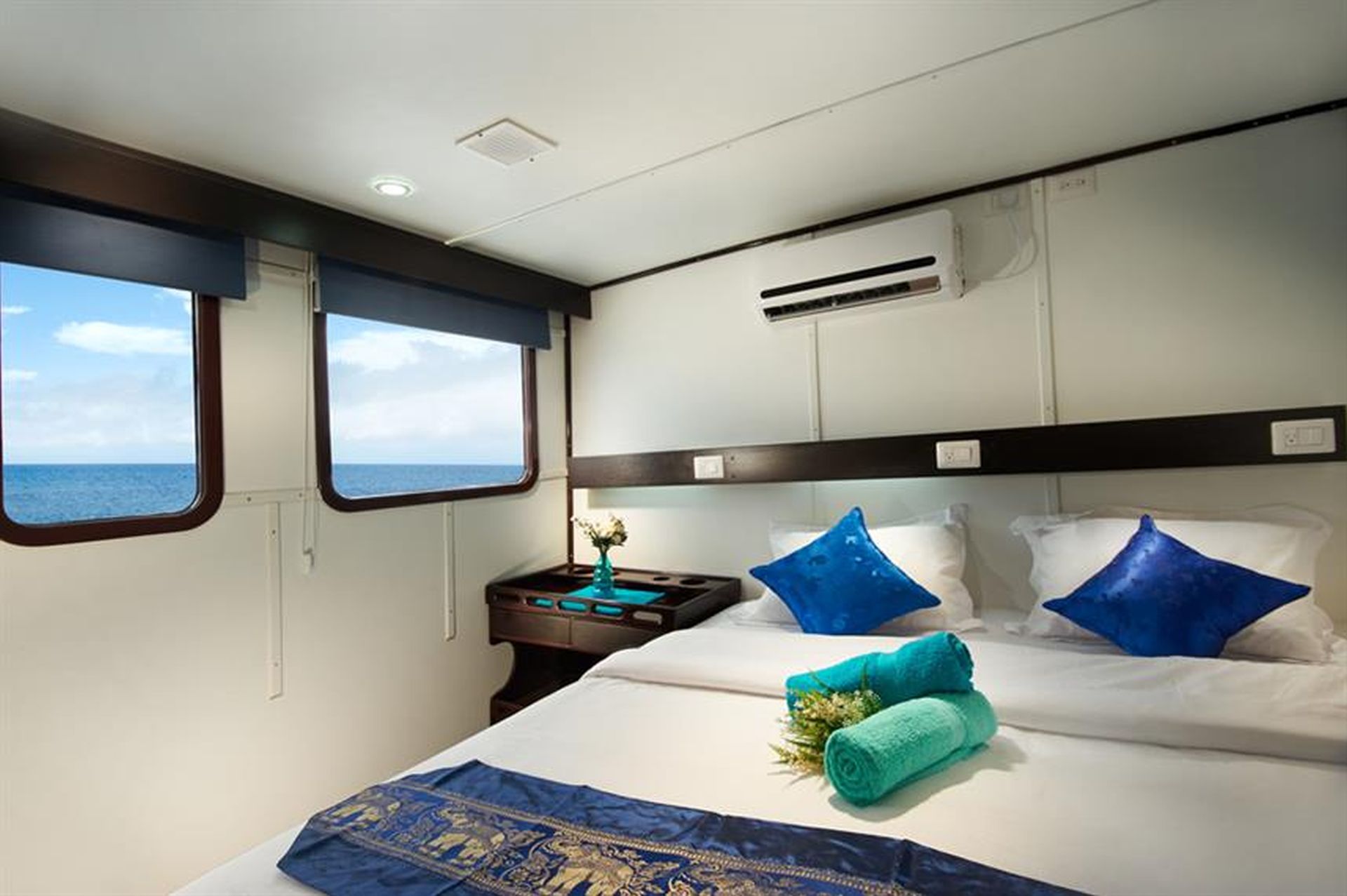GALAPAGOS MASTER
INFORMATION ABOUT GALAPAGOS MASTER
Known locally as Deep Blue, Galapagos Master is a 32 metre scuba diving liveaboard vessel which underwent a complete interior refit to the highest standards in 2015. Constructed from steel, the vessel is steadier than most due to being designed to be lower to aid stability and speed. Mostly recently refurbished in early 2023, Galapagos Master offers 7 and 10 night itineraries covering some of the top dive sites in the Galapagos.
She welcomes a total of 16 divers on each liveaboard trip, maximising safety and comfort for all guests on board. Featuring eight air-conditioned cabins spread across three decks, each has its own private en-suite bathroom with hot water, and ample storage room for all of your personal belongings. For added convenience and flexibility, Galapagos Master offers some cabins that can be used either as a twin or as a double bedded room.
The communal areas include a spacious indoor lounge on the middle deck where guests can relax and unwind while watching their favourite movie, or their latest underwater shots, on the plasma screen television.
The indoor dining area brings a tantalising array of mouth-watering meals, complimented by the adjacent cocktail bar. Photographers can take full advantage of the indoor camera set-up station which includes multiple charging points (US round pin plug). Additional storage drawers to the aft of the vessel mean that even photography charter groups will have no problem finding enough space for their equipment.
Technical Details
- Vessel type: Motor
- Year built: 2001
- Length: 32m
- Width: 7.5m
- Capacity: 16
- Hull: Steel
- Length: 32m
- Width: 7.4m
- Engines: 2
- Generators: 4
- Fresh water maker: 2
Safety
- First aid: Yes
- First aiders: Yes
- Emergency Oxygen: Yes
- Oxygen administrators: Yes
- Life Jackets: Yes
- Life Rafts: Yes
- Tender safety boxes: Yes
- VHF ship to tender radios: Yes
Vessel facilities
- Guests: 16
- Twin cabins: 4
- Double cabins: 4
- Ensuite: yes
- Air-conditioning: yes
- Towel change: yes
GALLERY
DIVE DECK
TWIN CABINS
GALLERY
Classic Twin/Double Cabin
- Located on the lower deck of the vessel, these versatile cabins offer flexible accommodation for two guests in either two single beds or one large double bed.
- PLEASE NOTE: These cabins no longer have windows or portholes.
- Ensuite bathroom
- Air-conditioning
- Ample storage
- Extra towels
PREMIUM TWIN/DOUBLE CABIN
- Located on the upper deck of the vessel, these spacious cabins offer flexible accommodation for two guests in either twin single beds or one double bed and provide stunning views along with ample storage and ensuite facilities.
- Ensuite bathroom
- Air-conditioning
- Ample storage
- Extra towels
DIVE FEATURES :
Currents:
One of the most challenging aspects of diving in the Galapagos is dealing with currents that can be too strong to swim against (2 to 4 knots at times). Overall, expect that currents will be moderate to strong. At most dive sites, the strength of currents is constantly changing, sometimes in the middle of the dive.
Drift Diving:
Because there are currents throughout the islands, and dives usually follow the flow of the current, most dives in the Galapagos are considered drift dives.
Surge:
Whenever current or swells are present, expect to find a surge in the shallow areas. After surfacing at the end of the dive, swim away from the island of rocks, out toward the blue so the dinghy can reach you easily, without worrying about being pushed onto the rocks by the surge.
Visibility:
Although there can be 30m (100ft) visibility in the Galapagos, more often it is in the 10-21m (30-70ft) range.
DIVING FACILITIES:
- Diving courses: No
- Rebreather friendly: No
- Equipment rental: Yes
- Nitrox membrane: Yes
- Charging station: Yes
- Photography friendly: Yes
- Compressors: 3 x Coltri-sub
- Tenders: 2
- Guides: 2
- Wetsuits / Drysuits
Layering is the best plan for diving in the Galapagos. 7 mm wetsuit with a lightweight hood, booties, and gloves is a good option or a dry suit with a full 5 mm hood will keep most divers warm and toasty.
About Itinerary
Our Galapagos itineraries involve some long-distance travel and, whilst we attempt to ensure the number of dives we have scheduled is fulfilled, bad weather and other factors can hinder the boat’s ability to reach a specified dive site in good time.
Due to the strength of currents, the last dive of the day must be made with plenty of daylight Transfers between San Cristobal Airport or local hotel and Galapagos Master on embarkation and disembarkation days are included in the liveaboard price.
Important information about diving in the Galapagos Diving in the Galapagos can be challenging, even for experienced divers. There are often tough conditions with strong currents and reduced visibility due to an influx of nutrients at certain dive sites which make the diving unsuitable for entry-level divers, or those who have not dived in similar conditions before.
ITINERARY DIVING - 8 DAYS
MONDAY
AM: San Cristobal Arrival and Transfer to the Boat
PM: San Cristobal Island: Lobos Island
THUESDAY
AM: Santa Cruz: Carrion Point
PM: Santa Cruz: Seymour Island
WEDNESDAY
AM: Cabo Marshall
PM: Cabo Marshall
THURSDAY
AM: Fernandina Island: Cape Douglas
PM: Isabela Island: Vicente Roca Point
FRIDAY
AM: Wolf Island
PM: Wolf Island
SATURDAY
AM: Wolf Island: El Derrumbe
PM: Wolf Island: La Banana
SUNDAY
AM: Darwin Island
PM: Darwin Island
MONDAY
AM: San Cristobal airport arrival
DAY BY DAY
AM: San Cristóbal
Embarkation between 14:00 and 14:30 followed by introductions, boat and safety briefings and lunch. There will usually be a shallow check dive scheduled in the afternoon.
After boarding at San Cristóbal, all diving guests on board Galapagos Master will carry out a check out dive. Carried out in a sheltered bay in an excellent shallow spot, at a max depth of
9m (30ft), this will allow you to check your dive gear but also become acquainted with some of the local marine life.
AM: Carrion Point
● Full breakfast and dive briefings
● Dives 1 and 2
● Lunch
● Afternoon land tour of North Seymour Island
● Dinner
Carrion Point
This boulder-strewn reef provides a superb introduction to some of the larger pelagics we expect to see in the Galapagos, including white tip reef sharks but also the occasional hammerhead and Galapagos shark. Sea lions are ever-present and there is the opportunity for some macro critter spotting with sightings of neon nudibranchs. The wall has an average depth of 15m (50ft) and mild-medium current is to be expected.
PM: North Seymour
Situated off the northern tip of Baltra Island, this site provides a stunning drift with sightings of white tip reef sharks, turtles, eagle rays and moray eels. The average depth is 18m (60ft) and a medium-strength current is to be expected.
PM: Mosquera
Located in between the islands of Baltra and North Seymour, this white sandy islet is not only home to a sea lion colony, but also supports a myriad of marine life; from manta rays and bonitos to Peruvian grunts and fields of garden eels. Occasionally, schools of hammerhead sharks may be seen here. Average depth 20m (70ft) with a typically mild current expected.
AM: Cabo Marshall
Full breakfast and dive briefings
● Dives 1 and 2
● Lunch, relaxation and dive briefings
● Dives 3 and, where possible, dive 4
● Dinner
Cabo Marshall
The craggy volcanic walls are covered with black coral bushes and the sheer variety of marine life is astounding. Sightings of manta, mobula and cownose rays are to be expected during the
warm season (November – May). Meanwhile, shark varieties include scalloped hammerhead, Galapagos and white tips. Schools of chevron barracuda and black striped salema are regular visitors along with yellowfin tuna and big eye jacks. And let’s not forget the sea lions and turtles!
AM: Fernandina Island
● Full breakfast and dive briefings
● Dives 1 and 2
● Lunch, relaxation and dive briefings
● Dives 3 and, where possible, dive 4
● Dinner
AM: Fernandina Island: Cape Douglas
Situated on the northwest point of Fernandina Island, this wall dive, with an average depth of 20m (70ft), offers something truly spectacular and is now famed for the feeding marine iguanas that congregate here along with sea lions, fur seals and speedy penguins!
PM: Isabela Island: Vicente Roca Point
Alternatively known as “The Ice Box”, due to its chilling thermoclines, this point off the northwest coast of Isabela Island offers a wall drift dive, along which mola mola can be spotted. The occasional Port Jackson shark may also be seen as well as the endemic Camotillo (White-spotted sand bass). Punta Vicente Roca is also a fantastic place to spot Pacific seahorses, frogfish, octopus, nudibranchs, flatworms and a variety of sponges. We stick to a maximum depth of 30m (100ft) with an average of 18m (60ft) while enjoying some milder currents!
Roca Redonda This underwater volcano, with its bubbling streams of natural gas (fumaroles) plays home to schools of hammerheads sharks and barracuda. Other commonly sighted marine life include
Galapagos sharks which typically come close to divers during safety stops, as well as manta rays, silky sharks and some beautiful green/blue nudibranchs. With typically strong, changeable currents and some down currents, the diving here is challenging, though with an average depth of 18m (60ft).
AM: Wolf Island
● Full breakfast and dive briefings
● Dives 1 and 2
● Lunch, relaxation and dive briefings
● Dives 3 and, where possible, dive 4
● Dinner
Named after the German geologist, Theodor Wolf, this extinct volcano reaches 253m (780ft) above sea level and lies some 160km (100 miles) northwest of Isabela Island. Land visits are not permitted; however, bird life, including red-footed boobies and vampire finch, may be spotted from the boat.
For our dives at Wolf Island, we choose from a selection of reefs and walls, most having typically medium to strong currents where the use of gloves is advised. Schooling pelagics are the main draw with sightings of hammerheads, white tips and Galapagos sharks at each site.
During the season (May – November) whale sharks may also be seen here. Divers should also be on the lookout for red-lipped batfish, barracudas, moray eels and dolphins.
AM: Wolf Island
● Full breakfast and dive briefings
● Dives 1 and 2
● Lunch, relaxation and dive briefings
● Dinner
El Durrumbe (the Landslide) - average depth is 20m (70ft).
La Ventana (the Window) – a shallow lagoon leading down to a pinnacle and then out along the reef wall - average depth 15m (50ft).
La Banana - Wall dive with an average depth of 9m (30ft) – can have strong currents.
Punta Shark Bay - Reef dive with an average depth of 20m (70ft) and usually good visibility.
However, care must be taken in the shallow water where waves crash up against the reef.
Anchorage - The reef, with typically a very mild current, provides a good spot for a sunset dive with an average depth of 18m (60ft).
Hat Island - another spot with a milder current, this reef provides sightings of numerous colourful fish species and an average depth of 20m (70ft).
Pinaculos (The Pinnacle) - known for its strong currents and speedy drift along the reef at an average depth of 20m (70ft), the site is excellent for shark spotting and the many cracks & crevices in the wall provide extra interest.
AM: Darwin Island
● Full breakfast and dive briefings
● Dives 1 and 2
● Lunch, relaxation and dive briefings
● Dinner
This extinct volcano reaching 165 metres (490 ft) above sea level was named in honour of naturalist Charles Darwin. It is amongst the smallest islands within the Galapagos Archipelago and like Wolf Island, land visits are not permitted.
Perhaps the most famed dive site is “Darwin’s Arch” which provides an amazing drift dive along the wall at an average depth of just 9m. Medium to strong currents are to be expected but bring large numbers of hammerheads, black tips, silky and Galapagos sharks with them.
Schools of jacks are a common sight, along with turtles, angelfish and moray eels. Occasional sightings of tiger sharks, manta rays and bottlenose dolphins make for a thrilling time spent here. Whale sharks may also be seen between May and November.
Sadly, on 18th May 2021, the top part of the iconic arch rock formation collapsed due to natural erosion but the pillars remain standing, and the surrounding dive site is still accessible with no effect on the marine life that has always delighted divers who have been luckyenough to visit before.
AM: San Cristobal
Disembarkation at 08:00 and visit to Interpretation Center.
*On days where afternoon land tours are included, only 2 morning dives will be offered.
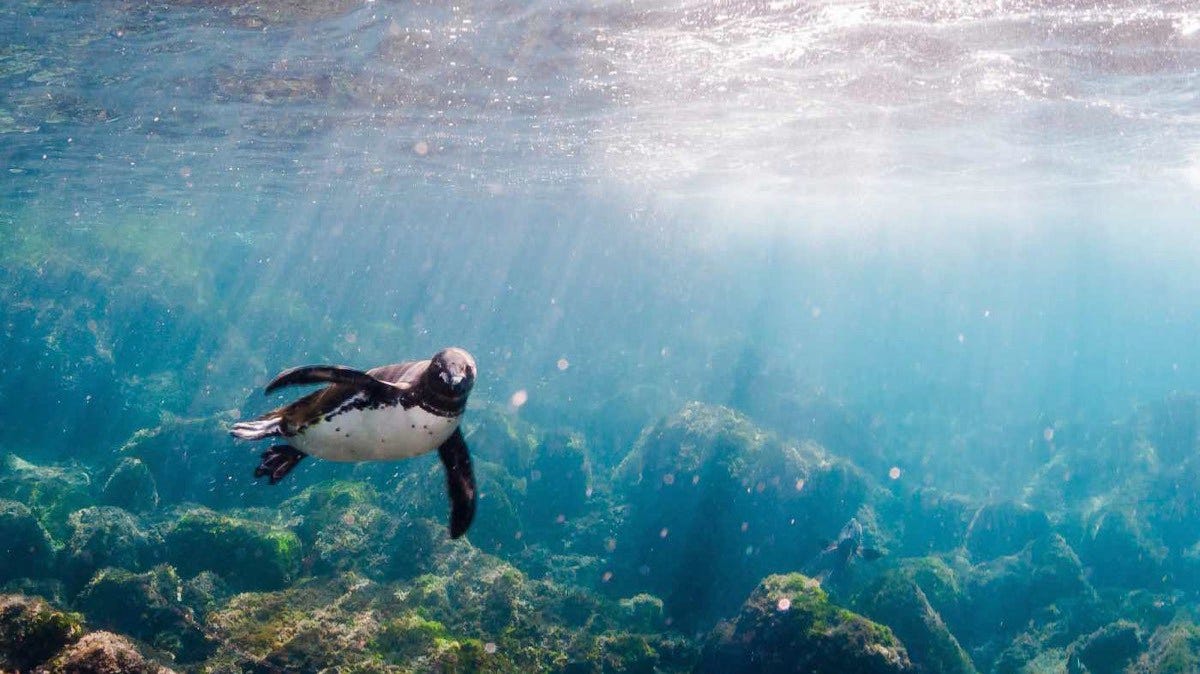
INCLUDED:
- All meals & snacks
- Accommodation in double room
- 7 nights/8 days aboard vessel.
- Full dive program of 2-3 dives per day
- Non alcoholic beverages
- Bath towels, deck towels and shampoo
- Weights and weight belts
- Disembarkation transfer
NOT INCLUDED:
- Flights to/from Galapagos
- Galapagos National Park Entrance fee ($200 per person) New rate apply since August 01st, 2024
- TCT visitor card ($20) Per Person.
- Recompression chamber fee ($35) Per Person.
- Fuel Surcharge
- Equipment rental
- Nitrox
- Alcoholic drinks
- Crew and dive guide gratuities
- On board merchandise
*PLEASE NOTE: It is not possible to get Diet Coke, Coke Light, Coke Zero, Diet Pepsi, or any other diet sodas in The Galapagos as they are not produced in recyclable bottles.
GET TO KNOW OUR RATES TO RENT THE DIVING GEAR
The person who rents the equipment is responsible for any loss or damage to the rented equipment while in his/her possession and agrees to return it in the same condition as received.
| GEAR | 7 NIGHTS CRUISE |
| FULL SET | $270,00 |
| BCD | $72,00 |
| BOOTIES | $30,00 |
| FINS | $30,00 |
| DIVE COMPUTER | $72,00 |
| MASK | $30,00 |
| REGULATORS | $72,00 |
| FULL-LENGTH WETSUIT | $72,00 |
| 15L CYLINDER | $72,00 |
| FULL DIVE KIT | $275,00 |
Notes: Full dive kit includes BCD, regulators, wetsuit, mask, booties, hoods and fins only and must be requested prior arrival in order to guarantee service.
Facts & Questions
There are many advantages to booking a liveaboard scuba diving holiday rather than land-based diving, not least of which is the convenience. Everything you could possibly want is provided within comfortable surroundings where you simply eat, sleep, dive and repeat as much (or little) as you want for the duration of your time on board. After assembling your equipment on the first day, there is no need to disassemble it until the last day, or carry it anywhere; you simply need to put in on (we’ll even help you with that if needed), then you’re all set for your next exciting dive.
We regret that we are unable to offer any diving courses on Galapagos Master.
Guests who are not Advanced Open Water certified (or equivalent) at the time of booking, or would like to become certified to dive with Enriched Air Nitrox, are advised to complete their training before the start of their liveaboard.
It is your responsibility to ensure that you are fit to travel and have had the required vaccinations for the countries you will be visiting. We are unable to give specific advice on vaccinations or other medical precautions as this information should be provided by a medical professional.
Please contact your local health adviser, pharmacy or travel clinic at least 8 weeks prior to departure for the latest advice and recommendations for your liveaboard destination.
Insect-borne diseases
All travellers are advised to take appropriate precautions to avoid being bitten by mosquitos and other insects, especially when on land.
Severe allergies
If you have a severe allergy, please inform us before you travel. If you have preventative or curative medication relating to an allergy please be sure to bring it (and a copy of your doctor’s prescription) with you.
Each Master Galapagos destination and itinerary has specific requirements regarding minimum certification level and diving experience. Please refer to the itinerary information pages, or consult our Diver Certification and Experience Requirements document, which can be found under General Information on our downloads page to ensure you meet these requirements.
Please be aware that divers who do not meet the minimum requirements for the itinerary they have booked, or who our crew feel lack sufficient experience in certain conditions, may be denied participation in some or all scuba diving activities.
As a general rule, Master Liveaboards does not allow children under the age of 16 (unless part of a full charter group or by prior agreement). Those between the ages of 16 and 18 years must be accompanied by a parent or guardian who will be responsible for their supervision at all times, including during dives.
In cases where consent has been given for a child under the age of 16 to join a trip, their supervision and behaviour onboard is the sole responsibility of their parent(s) or accompanying adult which may mean that parents or guardians are unable to dive together.
Guests are not advised to bring children under the age of twelve (12) on a liveaboard due to the environment and the nature of the holiday.
Most special dietary requirements, whether allergy or simply personal preference, can be catered for. However, in some destinations, certain products are not readily available and can be difficult to source. Please inform us of your requirements as far in advance as possible to ensure there are plenty of dishes to suit your needs.
PLEASE NOTE: We will of course try our best to meet your needs but cannot guarantee the availability of all requirements in destination. You are welcome to bring specific products with you, where permitted by local regulations, if the lack thereof may affect your wellbeing or holiday.
It is the responsibility of each diver to ensure that they are fit to dive.
Guests who have a pre-existing condition, even if it is controlled with medication, or have any symptoms that could be restrictive to diving need to obtain a doctor’s note clearing them to dive, prior to embarkation.
To this effect, all guests are required to read, complete and sign a medical statement AND provide proof of a doctor’s evaluation if the answer to any of the questions on the form is ‘Yes’. As this may not be possible in the destination we strongly advise guests to do so before travelling.
Any guests who are unable to complete the statement as directed, or provide a current doctor’s certificate (less than 1 year old) clearing them to dive may be denied participation in scuba diving activities during the liveaboard itinerary they have booked with us.
MORE DIVING TOUR OPTIONS
Price per person $6795
CALIPSO DIVING YACHT
Price per person $4795
AQUA DIVING YACHT
Price per person $6195
HUMBOLT EXPLORER
Price per person $6995
TIBURON EXPLORER
Price per person $6790
GALAPAGOS MASTER
Price per person $7395
GALAPAGOS SKY
Price per person $6765
GALAXY DIVER II
Price per person $3990
